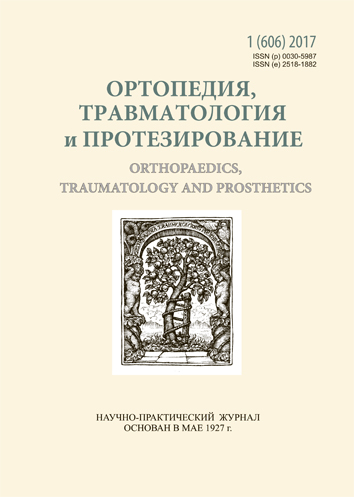Investigation of stress-strain state in spinal model for various methods of surgical treatment of thoracolumbar burst fractures (Рart one)
DOI:
https://doi.org/10.15674/0030-59872017127-33Keywords:
burst fractures, thoracic and lumbar spine, finite element method, stress-strain state, transpedicular fixationAbstract
There are different views on the treatment of burst fractures of the lower thoracic and lumbar spine. Some specialists prefer conservative methods of treatment, others use a spinal fusion of 360° (anterior and posterior). However, questions of the extent of fixation, its strength, the possibility of correction of deformation from the posterior approach, the feasibility of performing laminectomy, etc. are discussed.
Objective: to create a finite element biomechanical model of an burst fracture of the ThXIIvertebra body in the ThIX–LVvertebra block and analyze the stress-strain state in different fixation types.
Methods: three computational models of the ThIX–LVvertebra block were created with the destruction of 50 % of the body volume of the ThXIIvertebra and fixation: 1) ThIXand LV; 2) ThIX, ThXIIand LI; 3) ThX, ThXIand LI, LII, as well as variants of the model with destruction of vertebral pedicles.
Results: with the vertical load, the posterior spinal column is the most stressed, and the maximum stresses (45.9–46.6 MPa) in the fixing structures are located in the rods. In the case of fixation by 6 screws, the stresses in the rods are reduced by approximately 20 % (to 37.7–38.1 MPa). With the use of 8 screws, the total stress level compared to the fixation of 4 and 6 screws significantly decreased, in particular in the block of vertebrae LI–LValmost twice. Damage to the posterior support complex in the form of vertebral arches fracture led to a significant increase in tension (by 17 %) in the injured vertebral body only in a model with 4 screws.
Conclusions: the use of any transpedicular fixation leads to a decrease in stress in the damaged vertebra. With an increase in the number of screws in the fixing structure, the level of stresses decreases, but the pattern of their distribution in the spine does not change.References
- Sasso RC, Renkens K, Hanson D, Reilly T, McGuire RA Jr, Best NM Unstable thoracolumbar burst fractures: anterior-only versus short-segment posterior fixation. J Spinal Disord Tech. 2006;19(4):242–248. DOI:10.1097/01. bsd.0000211298.59884.24.
- Altay M, Ozkurt B, Aktekin CN, Ozturk AM, Dogan O, Tabak AY. Treatment of unstable thoracolumbar junction burst fractures with short- or long-segment posterior fixation an magerl type A fractures. Eur. Spine J. 2007;16(8):1145–1155. DOI:10.1007/s00586-007-0310-5.
- Popsuishapka KO. Metaanalysis of treatment results in lower thoracic and lumbar spine burst fractures. 2016;4:134-142. DOI: http://dx.doi.org/10.15674/0030-598720164134-142
- Liebschner MA, Kopperdah DL, Rosenberg WS, Keaveny TM. Finite element modeling of the human thoracolumbar spine. Spine. 2003;28(6):559–565. DOI:10.1097/01.BRS.0000049923.27694.47
- Lazoglu I, Akgun E. Rigid and dynamic spinal system modeling by finite elements methods. Intervertebral disc disease and dynamic stabilization of lumbar spine. Ed. A. F. Ozer. V. K. V. American Hospital Publications, 2011, рр.72–84.
- Langrana NA, Harten RD, Lin DC, Reiter MF, Lee CK. Acute thoracolumbar burst fractures: a new view of loading mechanisms. Spine. 2002;27(5):498–508.
- Strength problems in biomechanics: Textbook. Allowance for technical. And Biol. specialist. Universities. ed. I. F. Obraztsov. M.: High School, 1988. 311 p.
- Knets IF, Pfafrod GO, Saslgozis YuZh. Deformation and destruction of solid biological tissues. Riga: Zinatne, 1980. 320 p.
- Berezovsky VA, Kolotilov NN. Biophysical characteristics of human tissues: reference book. K.: Naukova dumka, 1990. 224 p.
Downloads
How to Cite
Issue
Section
License
Copyright (c) 2017 Volodymyr Radchenko, Konstantin Popsuishapka, Oleksandr Yaresko

This work is licensed under a Creative Commons Attribution 4.0 International License.
The authors retain the right of authorship of their manuscript and pass the journal the right of the first publication of this article, which automatically become available from the date of publication under the terms of Creative Commons Attribution License, which allows others to freely distribute the published manuscript with mandatory linking to authors of the original research and the first publication of this one in this journal.
Authors have the right to enter into a separate supplemental agreement on the additional non-exclusive distribution of manuscript in the form in which it was published by the journal (i.e. to put work in electronic storage of an institution or publish as a part of the book) while maintaining the reference to the first publication of the manuscript in this journal.
The editorial policy of the journal allows authors and encourages manuscript accommodation online (i.e. in storage of an institution or on the personal websites) as before submission of the manuscript to the editorial office, and during its editorial processing because it contributes to productive scientific discussion and positively affects the efficiency and dynamics of the published manuscript citation (see The Effect of Open Access).














